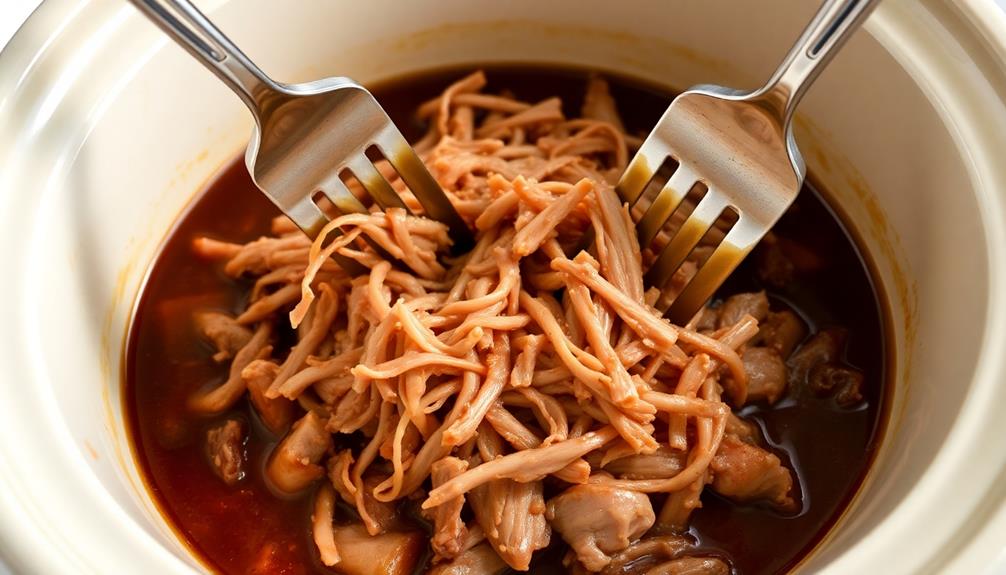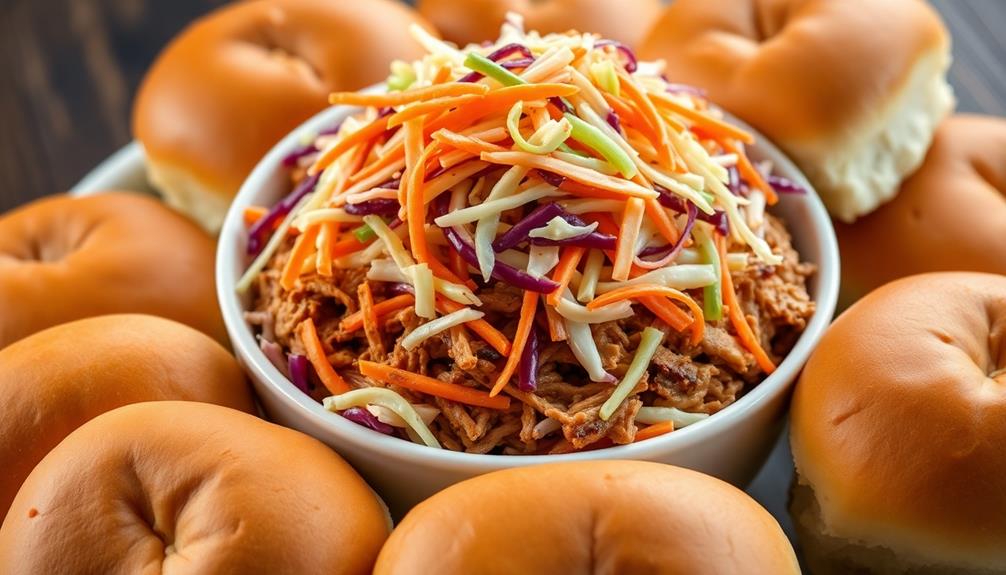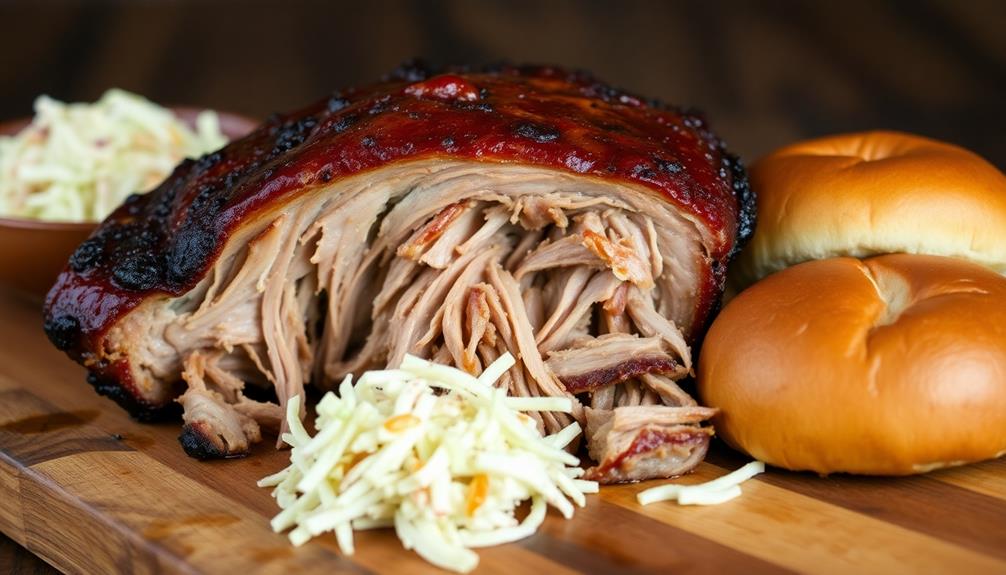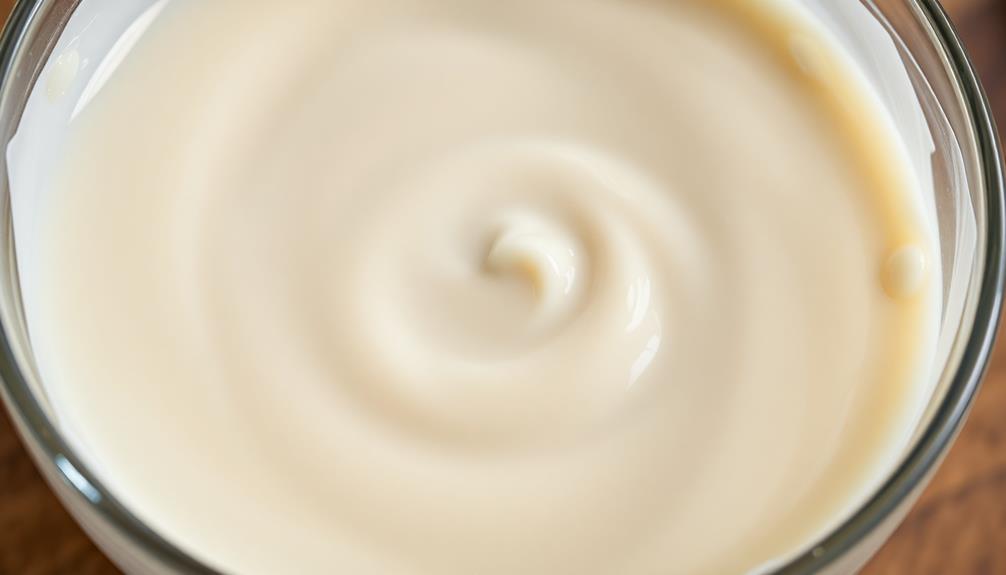You're gonna love this slow cooker pulled pork! It's got roots going back to the Caribbean, where folks would bury pork in banana leaves to get that fall-off-the-bone tender texture. Nowadays, you can make it right in your slow cooker – just toss in some pork, BBQ sauce, vinegar, and spices, and let it cook low and slow for hours. When it's done, you'll be able to shred that pork with ease. Serve it up on soft buns with coleslaw for a classic pulled pork sandwich, or get creative with leftovers. There's so much delicious history and flavor packed into this dish – let's dive in!
Key Takeaways
- Slow Cooker Pulled Pork is characterized by tender, flavorful meat achieved through lengthy cooking in a slow cooker, which maintains a consistent temperature.
- The recipe involves simmering pork in a sauce of BBQ sauce, apple cider vinegar, and brown sugar, along with a blend of spices, to break down connective tissues.
- The dish is typically served on soft buns, with coleslaw and optional toppings like diced onions, creating a balance of flavors and textures.
- Pulled pork offers a versatile and communal dining experience, suitable for various occasions, and the leftovers can be used in a variety of dishes.
- The dish represents a blend of historical cooking methods, such as Barbacoa from the Caribbean, and modern convenience, making it a beloved choice for many households.
History
Pulled pork has a long and storied history, dating back to the indigenous peoples of the Caribbean who first slow-cooked pork over low heat to preserve the meat.
They'd wrap the pork in banana leaves and bury it in the ground, allowing the meat to slowly tenderize and soak up all those delicious smoky flavors. This method, called "Barbacoa," was later adopted by Spanish settlers and eventually made its way to the southern United States, where it became a beloved regional dish.
Today, slow-cooked pulled pork is a staple in many households, thanks to the convenience of modern slow cookers.
The slow, gentle cooking process helps break down the tough pork shoulder into melt-in-your-mouth shreds, perfect for sandwiches, tacos, or simply enjoying on its own.
Whether you like it sauced or dry, pulled pork is a true taste of history and a delicious way to bring people together around the table.
Recipe
Slow Cooker Pulled Pork is a mouthwatering dish that fills the house with the irresistible aroma of tender, flavorful pork. This easy-to-make recipe allows the pork to slowly simmer in a delectable sauce, resulting in a dish that practically falls apart with a fork.
The key to achieving the perfect pulled pork lies in the lengthy cooking time. By allowing the pork to cook low and slow, the connective tissues break down, and the meat becomes incredibly tender and juicy. The slow cooker is the ideal tool for this task, as it maintains a consistent temperature and moist environment, ensuring the pork emerges fall-off-the-bone tender.
- 4-5 pounds boneless pork shoulder or butt
- 1 cup BBQ sauce
- 1/2 cup apple cider vinegar
- 2 tablespoons brown sugar
- 2 teaspoons smoked paprika
- 1 teaspoon garlic powder
- 1 teaspoon onion powder
- 1/2 teaspoon salt
- 1/4 teaspoon black pepper
Place the pork in a slow cooker. In a small bowl, whisk together the BBQ sauce, apple cider vinegar, brown sugar, smoked paprika, garlic powder, onion powder, salt, and pepper. Pour the sauce over the pork, ensuring it's evenly coated.
Cover and cook on low for 8-10 hours, or until the pork is extremely tender and shreds easily with a fork.
Once the pork is cooked, use two forks to shred the meat right in the slow cooker. Stir the shredded pork into the cooking liquid, allowing it to soak up all the flavorful juices.
Serve the pulled pork on buns, over mashed potatoes, or alongside your favorite sides. Enjoy this delicious and versatile dish!
Cooking Steps
Place the pork in your slow cooker, then add the spices and seasonings to give it that mouthwatering flavor.
Cook it on low for 8 hours, and when it's done, use two forks to shred the tender pork.
Serve it up with some fresh coleslaw and soft buns – you're in for a real treat!
Step 1. Place Pork in Slow Cooker

Begin by placing the pork shoulder or butt roast in your slow cooker. It's the star of this show, so you'll want to give it a nice, comfy home for the next few hours.
Nestle that big hunk of meat right in the middle, making sure it's not touching the sides. This'll help it cook evenly and get that delicious, fall-apart texture you're after.
Now, you might be tempted to cram in a ton of other ingredients right away, but hold up! We'll get to all the yummy seasonings in just a bit.
For now, let's just focus on getting that pork situated properly. Once it's in, give it a little wiggle to make sure it's settled nicely. You want it to be snug, but not squeezed in too tight.
This pork's got some serious cooking to do, so we want to make sure it has plenty of room to work its magic.
Step 2. Add Seasonings

Now that the pork is comfortably situated in the slow cooker, it's time to get those seasonings going! First, reach for your trusty jar of garlic powder and give it a few good shakes all over the pork. The garlicky aroma will make your mouth water in anticipation!
Next, sprinkle on some smoked paprika – this will add a lovely depth of flavor and a beautiful reddish hue. Don't forget the salt and pepper either – a few generous pinches of each will do the trick.
For an extra punch of flavor, try rubbing in a bit of brown sugar. The sweetness will balance out the savory spices perfectly.
Finally, if you're feeling adventurous, sprinkle on a dash of cayenne pepper for a kick of heat. Just be careful, a little goes a long way!
Give everything a good stir to make sure the seasonings are evenly distributed, then pop the lid back on the slow cooker. Soon, your kitchen will be filled with the most mouthwatering aroma – get ready for the most delicious pulled pork ever!
Step 3. Cook on Low for 8 Hours

With the seasonings evenly distributed, go ahead and set your slow cooker to low heat. This is where the magic happens! For the next 8 hours, your pork will gently simmer and become oh-so-tender.
You'll want to resist the temptation to lift the lid and take a peek – that will release all the delicious steam and slow down the cooking process. Just be patient and let the slow cooker do its thing.
As the hours pass, your kitchen will be filled with the mouthwatering aroma of succulent pork. You'll start to hear the pork sizzling and see the sauce thickening, which is a good sign that it's almost ready.
When the 8 hours are up, the pork should be falling apart easily with a fork. It'll be juicy, flavorful, and perfect for piling high on buns or serving over mashed potatoes.
Get ready for the best pulled pork you've ever tasted!
Step 4. Shred Pork With Two Forks

Once the 8 hours are up, it's time to shred the pork. Grab two sturdy forks and get ready to work your magic.
Gently lift the tender pork out of the slow cooker and place it on a cutting board or large plate. Using the two forks, start pulling and shredding the meat apart, creating those delicious, mouthwatering pulled pork strands.
Don't be afraid to really dig in and get a good grip – the pork should practically fall apart in your hands. Keep shredding until you've transformed the entire roast into a pile of succulent, stringy goodness.
Mmm, can you already smell the tantalizing aroma? This is the best part, where you get to transform the slow-cooked pork into the star of the show – juicy, flavorful pulled pork that's ready to be piled high on buns or served however you please.
Get ready to impress your family and friends with your expert shredding skills!
Step 5. Serve With Coleslaw and Buns

With the pork perfectly shredded, it's time to assemble the complete dish. First, prepare a fresh, crisp coleslaw to balance the richness of the tender pulled pork. Shredded cabbage, carrots, and a tangy dressing come together to create a cool, crunchy counterpart.
For a delightful breakfast pairing, consider serving it with Egg Rollup and Dumpling Sauce, which is a protein-rich option that complements the flavors well. Don't forget to toast the buns until they're lightly golden and slightly crispy on the outside – they'll provide the perfect bread to soak up all the delicious juices from the pork.
Now, it's time to build your sandwich! Pile high the juicy, mouthwatering pulled pork onto the fluffy buns. Top it off with a generous serving of the vibrant coleslaw, then dig in and enjoy the perfect harmony of flavors and textures.
The savory pork, tangy slaw, and soft, toasted buns make for an unbeatable combination that's sure to satisfy everyone at the table. Get ready for a flavor explosion in every bite!
Final Thoughts
Bringing this satisfying pulled pork recipe to a close, you can savor the richness of the meat, which has been cooked low and slow to perfection.
The tender, juicy pork is the star of the show, and the coleslaw and soft buns perfectly complement its flavors. As you dive into this mouthwatering dish, you'll be transported to a backyard barbecue, the smoky aroma filling the air and your taste buds eagerly anticipating each bite.
The beauty of this slow cooker pulled pork is its versatility. Serve it on its own, or get creative by topping it with your favorite sauces and toppings.
Drizzle on a tangy barbecue sauce, sprinkle on some diced onions, or add a dollop of creamy coleslaw – the possibilities are endless. Explore the world of regional BBQ sauce styles, from the vinegar-based sauces of North Carolina to the sweet and smoky flavors of Kansas City. Each style adds its own unique twist to your dish, elevating the flavors and creating a truly memorable dining experience. Whether you’re cooking up some ribs, pulled pork, or brisket, experimenting with different BBQ sauces and toppings can take your meal to the next level.
And don't forget to save any leftovers, as they make for a delicious sandwich or wrap the next day.
Frequently Asked Questions
Can I Use a Different Type of Meat?
You can certainly use a different type of meat in this recipe. The slow cooker method works well with various cuts of beef, chicken, or even lamb. Feel free to experiment and find your favorite variation.
How Long Can the Pulled Pork Be Stored?
You can typically store the pulled pork in the refrigerator for 3-4 days or in the freezer for 2-3 months. Be sure to store it in an airtight container to maintain freshness and prevent spoilage.
Do I Need to Sear the Pork Before Cooking?
You don't necessarily need to sear the pork before cooking. Searing can add some extra flavor, but it's not an essential step. The slow cooking process will still result in tender, flavorful pulled pork without searing.
Can I Add Additional Seasonings or Sauces?
Absolutely, you can add additional seasonings or sauces to your dish. Don't be afraid to experiment with different flavors and get creative. The slow cooker is a great way to infuse your meal with even more delicious taste.
Is It Possible to Cook the Pork on High?
Yes, you can cook the pork on high. It'll cook faster, but the texture won't be as tender as if you cooked it on low for longer. Just keep an eye on it to prevent drying out.









